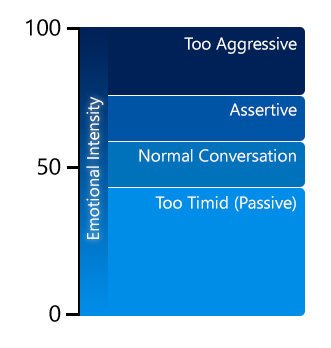How Assertive are You?
Assertiveness
Assertiveness is a form of communication that allows you to communicate your message in a confident, firm, and professional manner. Assertiveness allows you to make your point clearly heard; or deter others from trying to overwhelm you, with their more aggressive manner.
What is the correct amount of assertiveness?
This scale measures the intensity of emotion, ranging from 0 for no intensity of emotion, being too timid or passive, all the way up to 100, which is full-on emotional intensity, too much assertiveness or aggressive communication. 50 represents "normal conversational tones" - which is the ideal operating level.

Develop the ability to communicate with the correct amount of assertiveness. That way you will not be afraid to express your opinion in a meeting and you will be able to withstand the pressure of the social bully, dominating a situation by using an aggressive manner.
By using the correct level of assertiveness, you will avoid the perils of becoming the overbearing, over-assertive, aggressive person in the meeting. The aggressive personality might win battles but will lose wars, because over-assertive people tend to repel and therefore fail to gain the co-operation they need to achieve their goals.
How to achieve the correct level of assertiveness
There are four elements to assertiveness:
1. Assertiveness is primarily a state of mind
Assertiveness is achieved by focusing your mind on the content of the conversation, not on the status, or personalities of the people in the conversation.
2. Assertiveness uses polite language
Know what you want in any given context. When you know what you want, you must ask for it. Don't make demands. State your desires as polite requests.
Don't swear. By swearing you will cross the line from assertive to aggressive.
Always stay polite and request others do the same, refusing to speak to anyone who gets aggressive or swears at you.
3. Assertiveness is a tone of voice
The assertive voice tone is slightly louder than normal; slower in its rate of delivery and delivered at the deeper end of your natural voice range. The aggressive voice is too loud, too fast, and too shrill. Timid is too quiet.
People judge your emotional state very much by the tone of your voice. You display your emotions very much by means of changes in voice tones. If you are feeling confident, or scared, then it shows in your voice.
Therefore, if you want to be confident and assertive, control your voice tones.
4. Assertiveness is a form of body language
Assertive body language is achieved by using good posture: a straight back, and not slouching or leaning. Look as if you are alert and your mind is active.
Pointing at people is not an assertive gesture. It is an aggressive, angry gesture. Do not point your finger, or pen, or use a fist gesture.
Give sufficient eye contact. Too much eye contact will make you look aggressive and intrusive. Too little eye contact will make you look weak. Give the other person the same amount of eye contact that he is giving to you. Match and mirror the intensity and duration and frequency of eye contact. That will make you look assertive.
Assertiveness training
Assertiveness skills are important to you in the workplace since you will have to deal with difficult people. Assertiveness is a form of communication that allows you to be able to stand your ground and make your point heard, and yet not come on too strong and trigger a negative emotional response in the mind of your listener.
A good assertiveness training course will be able to help you to tread the middle ground between being, "too meek" and being "too pushy". When mastering the art of assertive communication skills, you will learn:
1. The need for you to make a firm decision to change
If you don't commit to making a change your current methods of thinking, speaking, and acting, then additional time spent in training will be of no benefit to you. Decide to improve your performance and use the knowledge. You have heard the phrase; "knowledge is power". It is power, only if you use it.
2. The ability to be able to explain exactly what you want
Assertiveness means being able to express exactly what you want. That ability, in turn, depends upon you knowing what it is you do want and having the words to express what you want.
3. The ability to be able to give constructive criticism
At work and at home, you need to be able to give constructive criticism to others who are not doing what you want, or who are doing things that you don't want. You must learn to give criticism in a constructive, not destructive, way.
Assertive constructive criticism is objective, specific, non-emotionalised, well-timed and suggests a specific corrective action. Assertiveness training teaches, and allows you to practice, a method of providing objective, specific, non-emotionalised, well-timed and constructive criticism.
4. The ability to be able to take constructive criticism
In addition to being able to dish out criticism, you must be able to take it.
Many people who lack assertiveness are oversensitive to criticism. Some are too easily offended and come out fighting. Others are too easily offended and lose all their confidence.
You need to be able to absorb criticism and to analyse the feedback to check if it is justified. If someone criticises you, then you should at least, listen to it and analyse it. If you think the feedback is true, or partially true, then you should make a change. You should always judge criticism accurately and objectively, and react to it properly in an intelligent, logical, non-emotional manner.
5. The ability to be able to give (and take) praise and appreciation
In addition to being able to take criticism, you must be able to take compliments and praise. Many people who lack assertiveness skills, also lack self-esteem and self-confidence and they feel uncomfortable with accepting praise. Some people are suspicious of praise. It is important to be able to accept praise. The best way to accept praise is simply to say: "Thank you".
In addition, it is important to be able to give praise and appreciation for the achievements and hard work of others. Praise should be timely, specific, clear and not exaggerated.
Our assertiveness training course will teach you all the above ways to become more assertive.
Definition: assertiveness
Assertiveness is a workplace communication style where a person states clear needs and views, while still respecting others' rights and feelings. It relies on calm, firm words, uses polite language, and is backed by confident body posture. When any of these parts are missing, the behaviour shifts to either passiveness or aggression.
Show CG4D Definition
- States clear needs and views without hesitation
- Respects the rights and feelings of others
- Uses calm, firm tone and polite language
- Shows confident, open body posture
Article Summary
Assertiveness means speaking with calm strength so your ideas are heard without crushing others. Pair clear words with steady tone, polite language and good stance, and you will handle meetings, bullies, praise and blame while gaining support.
Frequently Asked Questions
Here are some questions that frequently get asked about this topic during our training sessions.
What separates passive, aggressive and assertive behaviour?
What level on the assertiveness scale should I aim for?
How can my voice make communication more assertive?
Which body language signals show assertiveness, not aggression?
How do I stay assertive with an aggressive colleague?
How can I give constructive criticism assertively?
What’s the best way to accept praise assertively?
Thought of something that's not been answered?
Did You Know: Key Statistics
LinkedIn’s 2024 Workplace Learning Report shows that 68% of learning and development leaders list communication and people skills, including assertiveness, as their top training need, up from 55% in 2021. The CIPD Good Work Index 2023 found that 28% of UK employees experience interpersonal conflict at least once a month, but staff who have completed assertiveness training are 25% less likely to report such clashes.Blogs by Email
Do you want to receive an email whenever we post a new blog? The blogs contain article 5-10 minutes long - ideal for reading during your coffee break!
Further Reading in Assertiveness
-
Interpersonal communication skills training
Interpersonal communication skills training teaches feedback, active listening, delegation, persuasion and goal setting to cut conflict and lift team perform
Read Article > -
Five principles of confident communication
Discover five proven principles for confident communication. Get clear language, body and voice tips, plus a plan that boosts leadership and manager confidence.
Read Article > -
How to develop your personality
Learn how to develop an attractive personality by building vitality, compassion, productivity, honesty and humour. Follow steps to make people like, trust you.
Read Article > -
How assertive are you?
Use assertiveness, not aggression. Get clear tips on tone, stance and words to speak up in meetings, deter bullies, handle praise and feedback, and earn respect
Read Article > -
How to Be a Better Negotiator
Boost your negotiation skills with clear steps on BATNA, price moves and value gains. Learn to reach win-win agreements fast and walk away smart when needed.
Read Article >
Looking for Leadership and Management Training?
If you're looking to develop your Assertiveness Skills, you may find this Leadership and Management Training Course beneficial:
Open Training Course Pricing and Availability
Next Open Course Starts in 8 days, Cheltenham Gloucestershire, places available






